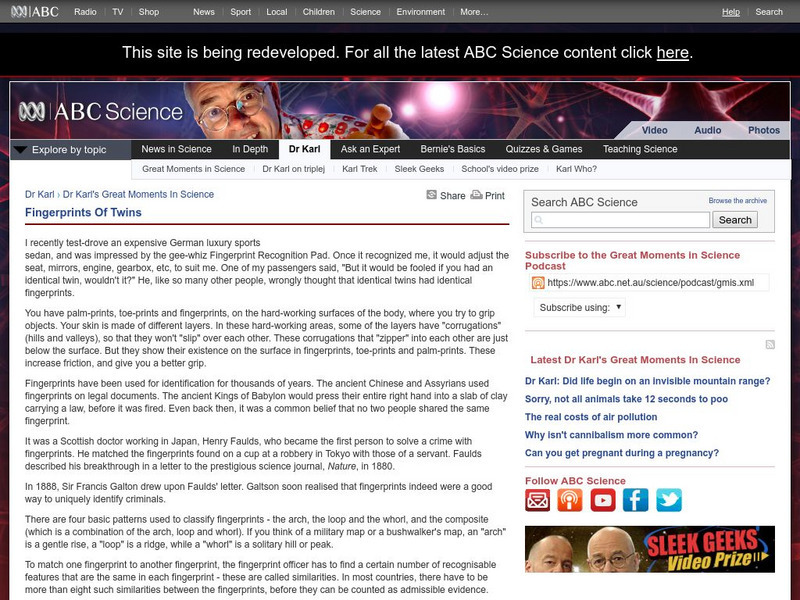PBS
Pbs: Never Say Die: The Clock of Life
This site from the PBS production, Scientific American Frontier "Never Say Die", includes a section entitled "The Clock of Life". It provides a discussion of cell death through shortening of the telomere. A good class activity included.
Australian Broadcasting Corporation
Australian Broadcasting Corporation: News in Science: Fingerprints of Twins
If you had an identical twin would you have the same set of fingerprints? Site uncovers the answer by researching the science behind fingerprints.
New York Times
New York Times: Crossword Puzzle: Genetics
The New York Times Learning Network has developed interactive and printable crossword puzzles. The theme of this puzzle is Genetics.
CK-12 Foundation
Ck 12: Meiosis
[Free Registration/Login may be required to access all resource tools.] How do you make a cell with half the DNA? Meiosis. This activity outlines the phases of meiosis, provides an overview of sexual reproduction, and describe how...
University of Utah
University of Utah: Learn Genetics: Bringing Rna Into View
What molecules were involved in the origin of life? This series explores the roles of RNA, DNA, and protein. Special attention is given to RNA because of its ability to perform several tasks necessary for life processes. All of the...
PBS
Pbs Learning Media: Some Genes Are Dominant
This interactive activity, adapted from the Dolan DNA Learning Center, illustrates how Gregor Mendel used purebred yellow and green peas to show that some genes are dominant and others are recessive.
PBS
Pbs Learning Media: Mendel's Laws of Genetic Inheritance
This interactive activity, adapted from the Dolan DNA Learning Center, uses Punnett squares to illustrate Mendel's laws of inheritance and how a particular gene combination results in a 3-to-1 ratio of dominant-to-recessive traits.
Houghton Mifflin Harcourt
Harcourt: Biographies: Rosalind Franklin
This is a fantastic biography of Rosalind Franklin. It has links to both additional information and images to help illustrate the biography.
Concord Consortium
Concord Consortium: Molecular Workbench Showcase: Biotech
Simulations of common biotechnology techniques performed in a laboratory setting. Learn how to complete these techniques and what task they are used for in the lab.
National Institutes of Health
Niehs: Kids' Pages: You and Your Genes
Online children's story that teaches about genes and how they direct how you react to things in your environment. Click on "next" at the bottom of the story to see how different people respond differently to harmful substances.
Khan Academy
Khan Academy: Answers to Exploration Questions: Human Evolution
On this site, find answers to the exploration activity on human evolution. Questions discuss both physical traits of hominid as well as DNA evidence.








